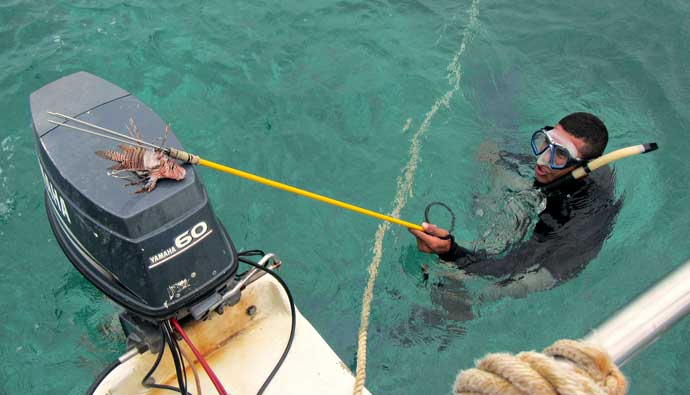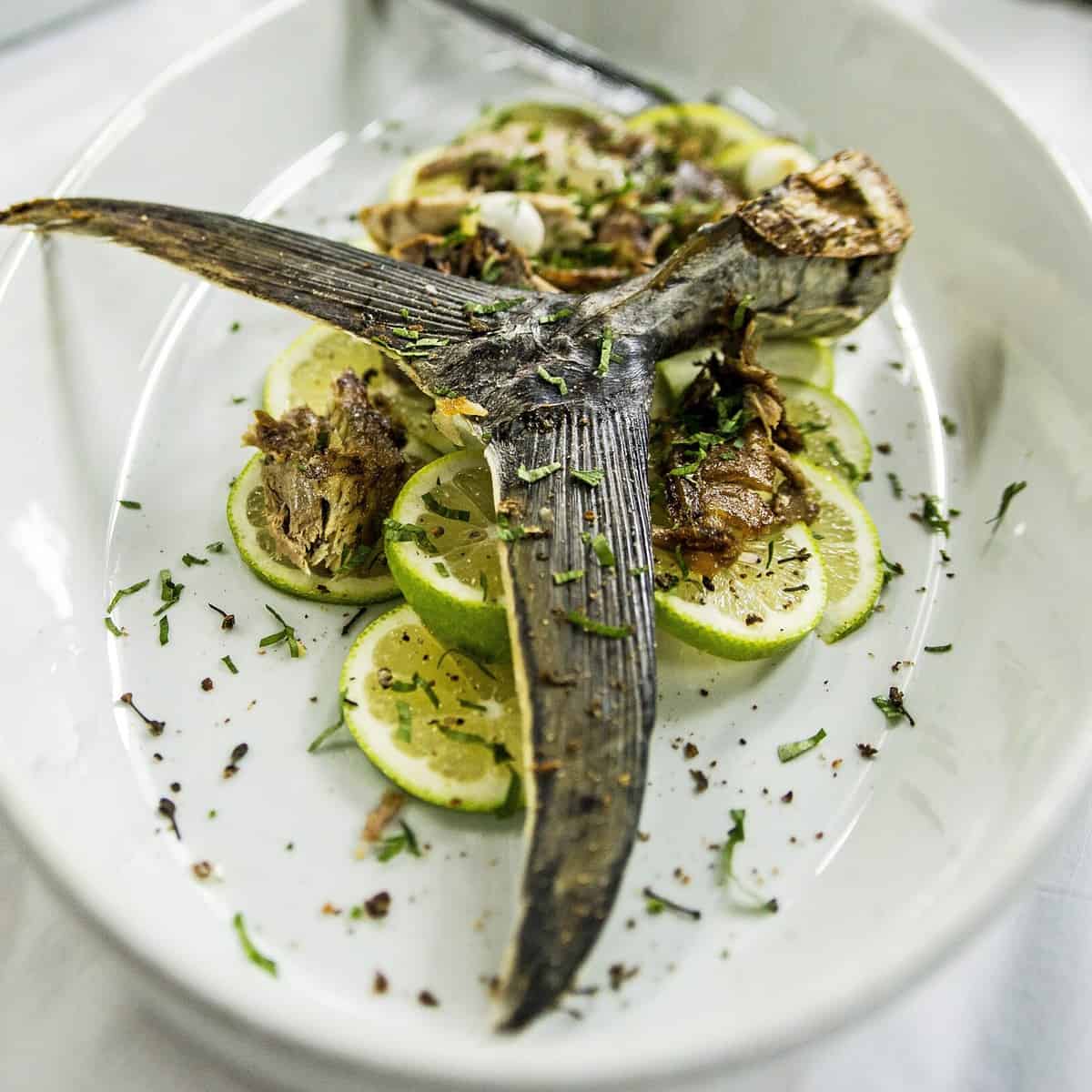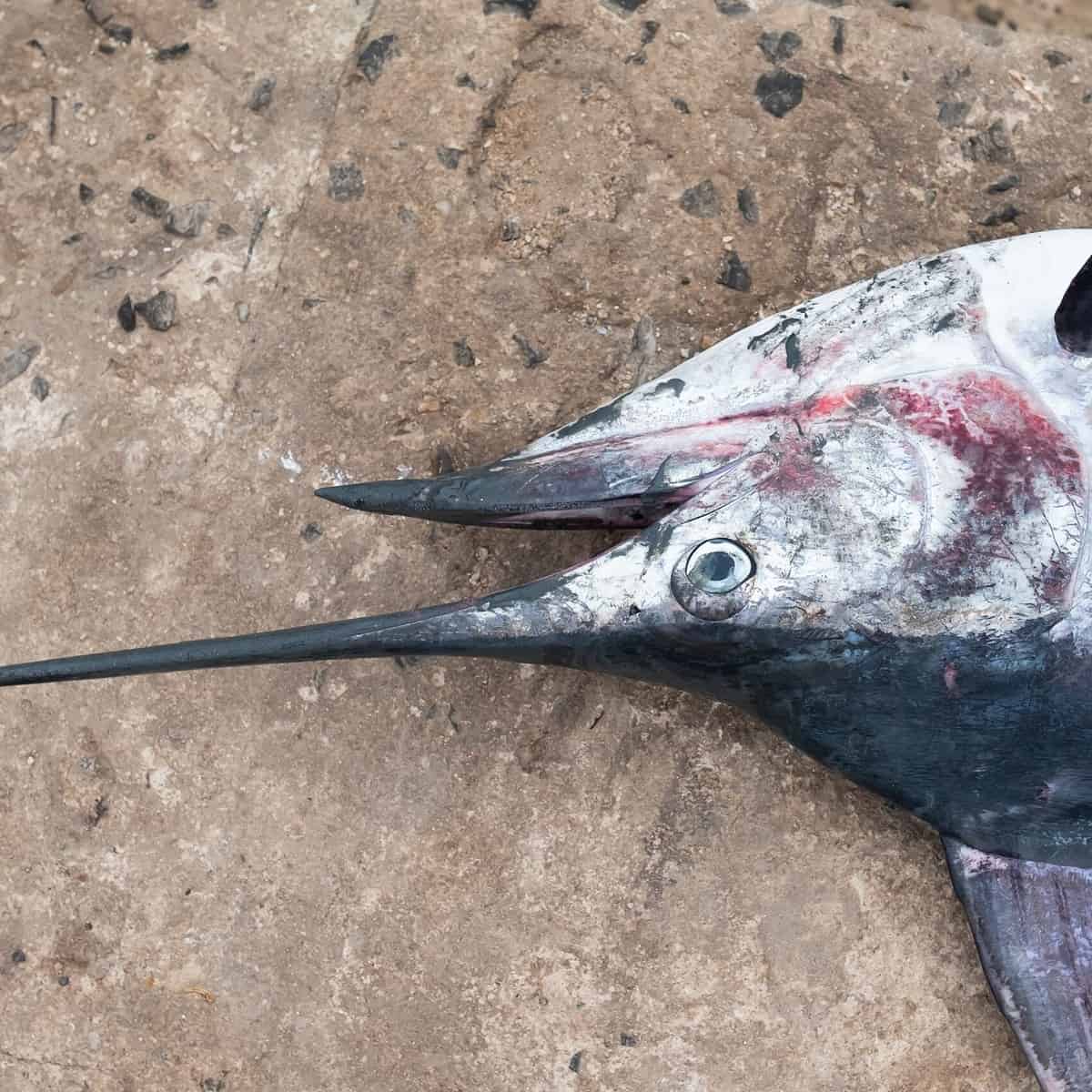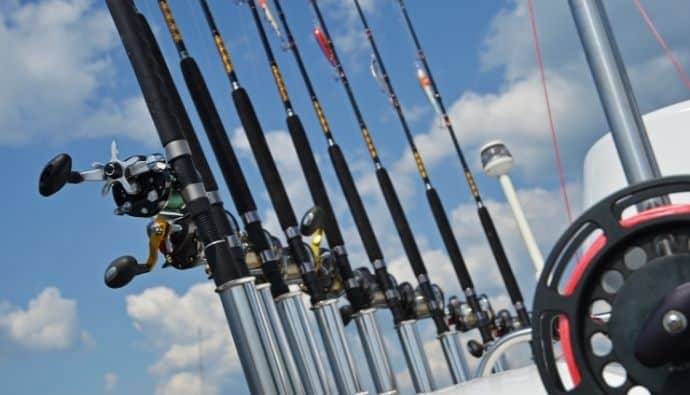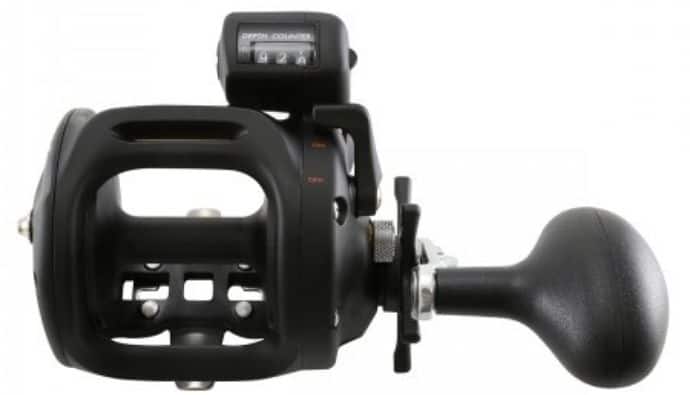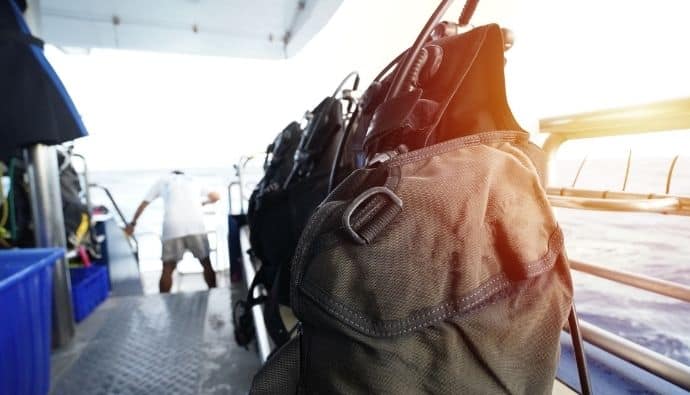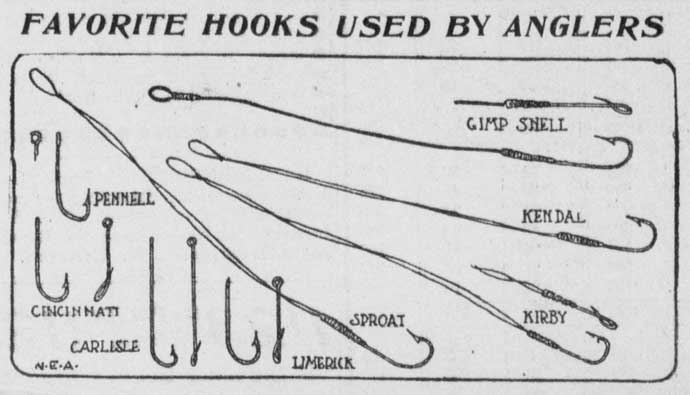Not having the right spearfishing gear when entering the ocean is dangerous.
Too many spearos have become frustrated or worse been put in situations that can lead to disastrous consequences due to bad gear selection. Take for example a bad dive knife.
Spearfishing Gear for Beginners
- Speargun or Pole Spear
- Freediving Mask
- Freediving Snorkel
- Spearfishing Wetsuit or Dry Suit
- Weight Belt
- Freediving Fins
- Freediving Socks
- Spearfishing Gloves
- Dive Knives
- Spearfishing Float
- Floatline
- Spearfishing Reel
- Dive Flag
- Freediving Watch
- Underwater Fishing Camera
- Spearfishing Bag
- Optional: Ocean Kayak
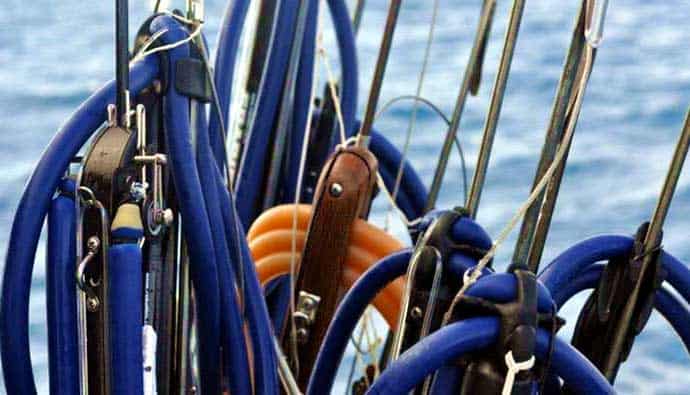
You’re in the water and get caught in a net that’s drifted your way. You pull out a cheap knife that hasn’t been sharpened and you’re trying to cut yourself free…
But it’s not cutting.
Now you’re stuck with this big net slowly wrapping around you and you’re at least half a mile from shore. You try and signal your buddy but he’s not paying attention.
This wouldn’t have happened if you had a better knife!
The list goes on but you get the point. Decisions you make before entering the water affect your time in the water.
Let’s dive into the essential spearfishing gear items you need to think about before getting in the water.
It doesn’t have to cost a lot of money, but there are certain pieces of equipment that are a must for when you are just starting out.
17 Essential Spearfishing Gear
It is extremely important to have the proper free diving gear when just starting out because you have to be able to see what you’re looking for.
At a bare minimum, you’ll need a speargun, freediving mask, snorkel, fins, and a weight belt.
Having the right snorkel allows you to be able to breathe properly without continuing to raise your head out of the water. If you are constantly raising your head out of the water or fiddling with your mask because it’s leaking, you’ll never cover the kind of distance required to be a hunter…
On top of that, without the proper freediving fins, you might as well be a fish out of the water.
While you might catch a few fish with the bare minimum gear, if you have it all, you’re spearfishing game will jump to the next level!
1. Speargun
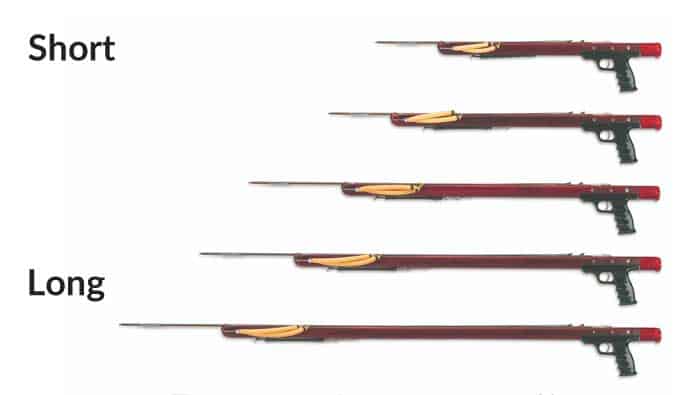
Spearguns come in different styles. For a beginner, it’s helpful to get a gun that is right for the place you’re diving, easy to use, and robust so it doesn’t break.
Aluminum pipe guns are recommended between 70-110cm. It’s not important to go with a roller gun until you’ve been spearing for a bit. Keep it simple. Two bands will suffice.
2. Pole Spears

Not all spearos like using a speargun every time they go on the hunt. Pole spears make great hunting tools, especially around reefs and areas that don’t require a powerful gun to get the fish.
Some spearos also take pole spears to the next level by using them in the blue water. This requires the ability to get close to the fish and hit them while the slip tip is attached to a float line and float.
It’s always good to have a pole spear in your arsenal to keep the hunt exciting.
3. Freediving Mask

It is highly advisable for anyone who is a beginner at spearfishing to have a black low-volume mask.
The alternative, a clear silicone mask will cause a glare from the sun because a beginner will be on the surface a lot. The black low-volume mask cuts the glare.
Tips on How to Make Sure Your Freediving Mask Fits
- Tilt your head back and rest the mask on your face without putting the strap on.
- Make sure that every part of the mask is positioned properly.
- Breathe in through your nose to create a seal between your face and the mask. As you breathe in, tilt your head to a normal position. If it stays on your face without air leaks, it is a good fit.
- If it falls off your face, you will need a mask of another size because that particular skirt doesn’t fit your face. You will need to continue trying them on until you find the right fit.
- If it fits properly, use your hand to hold the front of the mask, while putting the strap over your head.
- You should now be able to adjust the mask so that it fits comfortably on your head.
- Once this is complete, you are ready to get in the water.
PRO TIP: Do all this before you head to the ocean for the first time in order to ensure that your mask fits.
Following the above steps will speed up the process once you do get in the water with your new mask.
4. Freediving Snorkel
Simple is key when it comes to snorkels. If you have regular snorkeling snorkels with the valve at the bottom, they tend to let in water at the worst time…right when you’re about to take that big breath and dive down.
Make sure you get a snorkel without the valve to prevent this.
It’s also helpful to get a snorkel that is flexible so it is able to bend a bit as necessary when you’re moving around in the kelp.
5. Spearfishing Wetsuit
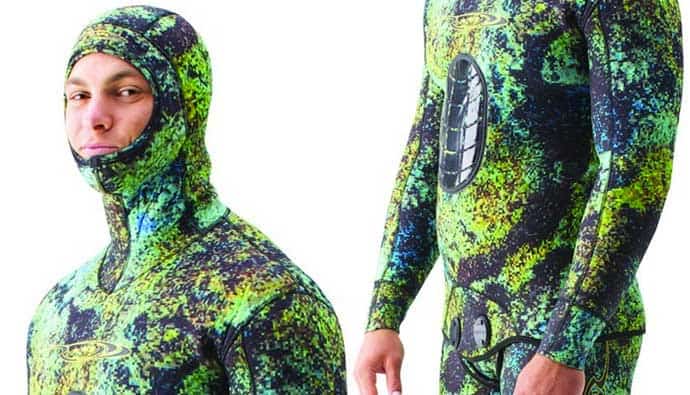
Spearfishing or freediving wetsuits for women and men are important because they keep you warm. Keeping warm as a free diver is important because if you are cold, you won’t enjoy the experience of freediving in the ocean or lake.
Also, freediving wetsuits can keep you protected from rocks when you are entering or exiting the water.
A lot of freedivers think they can dive with a regular surfing wetsuit. The reason this is not advisable is that they are not as comfortable as the freediving suits, which are made out of Chloroprene, which is a super flexible and comfortable.
Most freediving suits come in 1.5 mm, 3.5mm, 5mm, or 7mm.
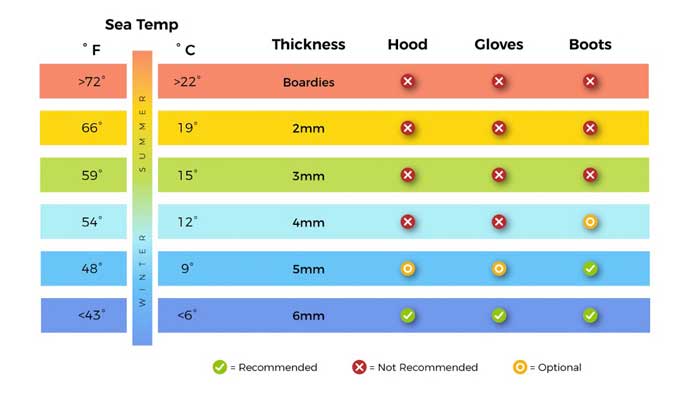
- 1.5mm is for 75-degree water or warmer.
- 3.5 mm is for 67-75 degree water.
- 5mm is for 60-67 degree water.
- 7mm is for 50-60 degree water.
Keep in mind that if you don’t have a lot of body fat, you are going to get colder faster in the ocean. This is precisely why you should wear a thicker suit in order to stay warm.
It’s better to be a little too hot than to be a little too cold. If you’re too cold, your enjoyment of your diving experience will be hampered.
Most freediving suits are two-piece wetsuits. This helps provide more wetsuits on your chest, which necessarily keeps you warmer.
In the two-piece wetsuits, you have either the Farmer John bottoms (“pant”) or high-waist pants.
In both cases, there is a hooded top with a beavertail.
You can also get the Riffe Steamer if you want a one-piece, non-hooded wetsuit. Another option is to get a lycra hood (to keep your head warm in colder water).
The Steamer comes in 1.5mm 100% Yamamoto neoprene, which is a flexible material. It almost feels like you don’t even have a wetsuit on. The Steamer is mostly used for tropical water, which means 77 degrees or warmer.
6. Freediving Weight Belt
If you can spend a bit more, you should get a rubber belt. The rubber belt will be more comfortable and you are less likely to lose it.
Weights aren’t cheap and it’s important to add just enough to negate the buoyancy of your body and wetsuit in the water. You should get your weights from a dive shop so they can give you the proper amount.
Some spearos add weight to negatively buoyant themselves, however, this can be dangerous especially if you shallow water blackout.
7. Freediving Fins
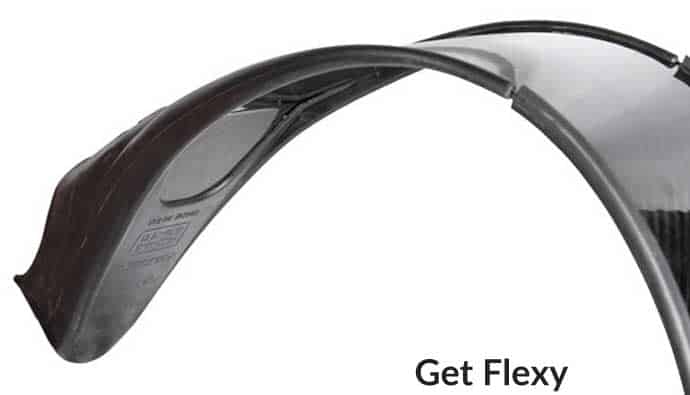
Longer freediving fins are better for free diving. When you are free diving, ideally it is a long, slow kick, using the entire leg. One reason for this is because the goal is to use less oxygen.
When purchasing a set of fins, some require a set of fin keepers. They keep your fins from falling off your feet. Also, it eliminates noise and prevents energy loss and sores.
8. Freediving Socks

Freediving socks are important for keeping your feet protected within your freediving fins. They also have an extra benefit for keeping your feet warm in the water since they are located far away from your heart.
Freediving socks will be one piece of gear that you’ll need to replace fairly regularly. They are constantly getting rubbed against which will wear at the neoprene.
Some spearos also use them to walk from their car to the beach. This tends to shorten the life of the socks by ripping holes in the bottom. Try to use waterproof sandals when crossing rough terrain.
9. Dive Gloves
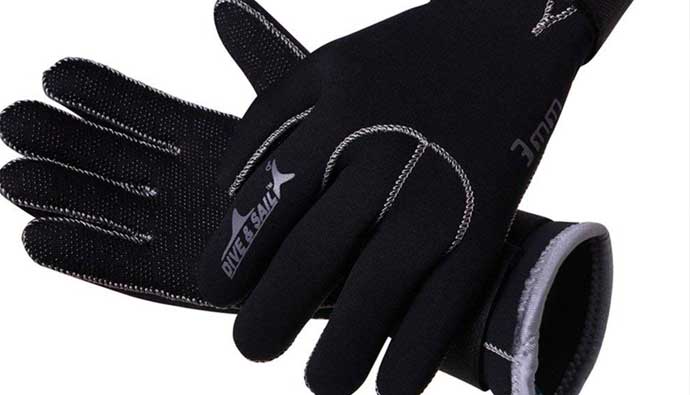
Diving gloves are important because they keep your hands warm and protected. Certain gloves have better dexterity when handling anything in the water (i.e., your gear, fish, lobster, gun, etc.)
Dyneema gloves are good for catching lobsters. They protect your hands while handling the lobster’s sharp points on its body. Also, some fish have sharp gill rakers inside their gills.
Dyneema diving glove keeps your hands safe from gill and tooth scrapers, lobster stabs, and anything else sharp that could cause infection if there was no protection.
10. Dive Knives
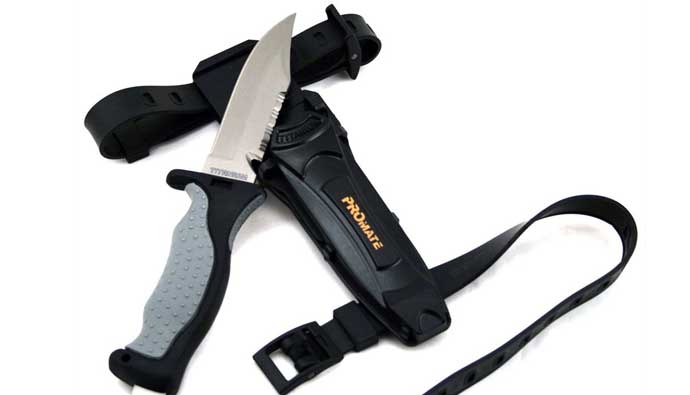
Always carry a dive knife, it could save your life. Most spearos carry more than one for added protection.
Here are some of the reasons why I carry a knife:
- You can cut yourself out of any situation (including cutting yourself out of kelp, your line, etc), which can save your life.
- You can use the knife to kill your fish. This is the ethical thing to do after you spear it since you don’t want to make it suffer any longer than it has to.
Riffe Dive Knives
- Spearfisher – overall length is 8.5”; blade length is 4.5”
- Silencer – overall length is 9.5”; blade length is 4.5”
- Terminator – overall length is 9.5”; blade length is 4.5”
Riffe Knife Accessories
- The Lanyard keeps the knife on your wrist.
- Forearm/Leg Stretch Straps
- Rubber Knife Keeper
- Plastic Sheaths to protect yourself from getting stabbed
11. Spearfishing Float
Spearfishing floats are handy when you are diving from the shore and want to be visible. They are also important when you are bluewater hunting and spear large fish like tuna and need them to fight against the float before bringing them in.
Floats come in a wide range of shapes, sizes, and pressures. When possible opt for a low profile brightly colored one if you’re going through kelp forests. If you’re going in the bluewater, get a high-pressure one as the fish out there are powerful and you’d hate to lose your speargun or rod.
12. Spearfishing Float Line
Float lines are important for keeping your gun safe after you hit a fish. If the fish is medium to large in size, it’ll take the speargun from your hand and be lost forever if it’s not attached to a float line.
Some people use float lines without floats or a small kelp carrot when hunting in kelp to make it easier to move.
It seems to be advised to use a float line over a reel as they are safer especially when a reel freezes up, which will make you lose your gun or increase your chances of shallow water blackout.
13. Spearfishing Reel
Any time you hit a fish and you don’t stone it, you’re going to need to bring the fish in by hand using a float line or reel. Reels are nice because they are low profile and make it easier to travel through the water.
Reels have a chance of seizing up if you don’t take care of them so make sure to rinse them after each use and take care of the moving components.
Opt for a bright color line to make it easier to see the line in the water.
14. Dive Flag
Diving with a dive flag is required by law in many states and countries. The two types of dive flags are the diver down flag and the alfa flag.
The alfa flag is internationally recognized, whereas the diver down flag is more commonly used in the states to show where a diver entered the water.
For your safety, it’s important to make sure you have a diver down flag so other boaters can see where you are in the water and stay away from your area.
15. Freediving Watch
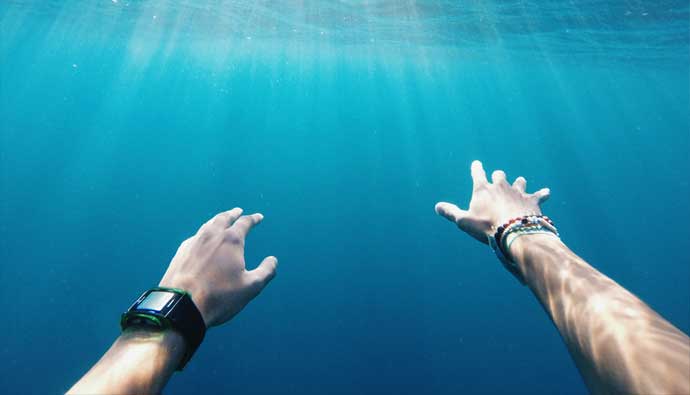
Not all freedivers opt to use a freediving watch, but if you like to know the data on your dives, it’s recommended that you get one.
Freediving watches keep track of your depth time, come with alarms to keep you aware of your dives, and track environmental conditions like water temperature.
It’s recommended to have a dive watch to keep track of the intervals of your dives. Shallow water blackouts come when you don’t let your body recover effectively between dives. A good freediving watch takes the guesswork out of this.
16. Underwater Fishing Camera
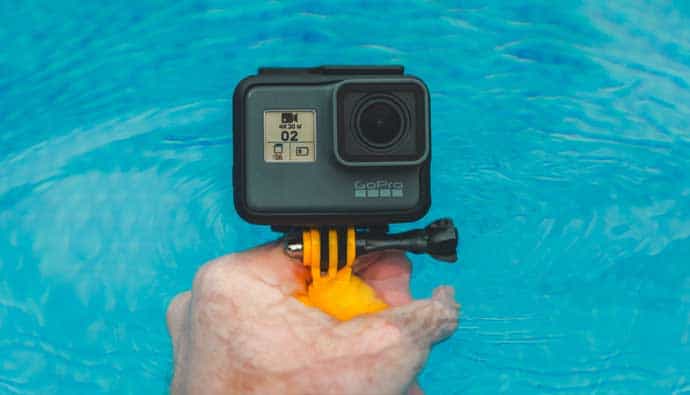
If you didn’t catch it on film, it never happened. Just kidding, but if you can record your hunts, you’ll have the ability to share your passion with others.
The best underwater fishing camera for spearos is a GoPro. If you want clarity and the form factor, nothing beats its quality.
What’s crazy is that there are other types of fishing cameras that not many people know about such as bobber and lure cameras. Fishing is getting high-tech!
17. Spearfishing Bag

Now that you have all of this gear, you’ll need a bag to put it in. Not all bags are created equal.
If you’re on a budget you can throw everything into a big duffel bag, but then all of your expensive gear will crash against each other lessening their lifespans.
I personally like spearfishing backpacks that have room for my speargun, fins, wetsuit, and everything else and make it easy to walk from my car to the beach. Many times I have to climb down a cliff so having the weight on my back makes it much safer than carrying things in my hands on over my shoulder.
Spearfishing Gear Advice
It’s important to get quality gear before you head out into the water and put them to the test. Most spearos go to a freediving shop without doing their research ahead of time, which put them at the mercy of the salesperson.
Hopefully, all of these guides have helped you get a better understanding of what you need to get started in spearfishing.
I know I wish I had them before I stepped foot at the dive store and spent way too much on overpriced items. Don’t make the same mistake!





 Facebook
Facebook YouTube
YouTube
